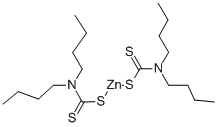Ethyl ziram
- CAS NO.:14324-55-1
- Empirical Formula: C10H20N2S4Zn
- Molecular Weight: 361.93
- MDL number: MFCD00064798
- EINECS: 238-270-9
- SAFETY DATA SHEET (SDS)
- Update Date: 2024-12-18 14:08:52

What is Ethyl ziram ?
Chemical properties
White powder. Soluble in carbon disulfide, benzene, and chloroform; insoluble in water.
The Uses of Ethyl ziram
Rubber vulcanization accelerator, especially for latex foam; heat stabilizer for polyethylene.
The Uses of Ethyl ziram
Diethyldithiocarbamate zinc is a rubber component used as a vulcanization accelerator. It can be responsible for rubber dermatitis in healthcare personnel. It was contained in the "carba-mix".
The Uses of Ethyl ziram
Zinc diethyldithiocarbamate is a chelating ligand. It is used as a common accelerator to latex. A fast curing primary or secondary effective ultra-accelerator for natural and synthetic latex compounds.
Background
Ditiocarb zinc, also known as Diethyldithiocarbamic acid zinc salt, is a known chelator for copper and zinc. It also a dermatological sensitizer and allergen. Sensitivity to ditiocarb zinc may be identified with a clinical patch test.
Indications
Ditiocarb Zinc is approved for use within allergenic epicutaneous patch tests which are indicated for use as an aid in the diagnosis of allergic contact dermatitis (ACD) in persons 6 years of age and older.
What are the applications of Application
Zinc diethyldithiocarbamate is a chelating agent
Definition
ChEBI: Zinc diethyldithiocarbamate is a dithiocarbamate salt that is the zinc salt of diethyldithiocarbamic acid. It is an accelerator and activator for natural rubber. It has a role as an antifungal agrochemical. It is a dithiocarbamate salt and a zinc molecular entity. It contains a diethyldithiocarbamate and a zinc(2+). It is functionally related to a diethyldithiocarbamic acid.
Hazard
Strong irritant to eyes and mucous membranes.
Flammability and Explosibility
Not classified
Contact allergens
Diethyldithiocarbamate zinc is a rubber component used as a vulcanization accelerator. Oxidation of this carbamate leads to tetraethylthiuram disulfide. It can be responsible for rubber dermatitis in health personnel. It was contained in “carba-mix.”
Safety Profile
Poison by intraperitoneal route.Moderately toxic by ingestion and subcutaneous routes.Severe irritant to eyes, nose, and throat. Questionablecarcinogen with experimental carcinogenic andtumorigenic data. Mutation data reported. When heated todecompos
Metabolism
Not Available
Purification Methods
Crystallise this herbicide several times from hot toluene or from hot CHCl3 by addition of EtOH. It also crystallises from xylene, m 180o. [Beilstein 4 II 613.] TOXIC.
Properties of Ethyl ziram
| Melting point: | 178-181 °C (lit.) |
| Boiling point: | 330.6°C (estimate) |
| Density | 1,48 g/cm3 |
| vapor pressure | 0.007Pa at 25℃ |
| Flash point: | 204°(400°F) |
| storage temp. | under inert gas (nitrogen or Argon) at 2-8°C |
| solubility | DMSO (Sparingly), Methanol (Slightly, Heated, Sonicated) |
| form | solid |
| color | White |
| Specific Gravity | 1.48 |
| Water Solubility | Insoluble in water. Soluble in benzene carbon disulfide and organic liquids. |
| Hydrolytic Sensitivity | 4: no reaction with water under neutral conditions |
| CAS DataBase Reference | 14324-55-1(CAS DataBase Reference) |
| NIST Chemistry Reference | Bis(diethyldithiocarbamate)zinc complex(14324-55-1) |
| EPA Substance Registry System | Ethyl ziram (14324-55-1) |
Safety information for Ethyl ziram
| Signal word | Warning |
| Pictogram(s) |
 Exclamation Mark Irritant GHS07  Health Hazard GHS08  Environment GHS09 |
| GHS Hazard Statements |
H302:Acute toxicity,oral H315:Skin corrosion/irritation H317:Sensitisation, Skin H319:Serious eye damage/eye irritation H335:Specific target organ toxicity, single exposure;Respiratory tract irritation H373:Specific target organ toxicity, repeated exposure H410:Hazardous to the aquatic environment, long-term hazard |
| Precautionary Statement Codes |
P273:Avoid release to the environment. P280:Wear protective gloves/protective clothing/eye protection/face protection. P314:Get medical advice/attention if you feel unwell. P301+P312:IF SWALLOWED: call a POISON CENTER or doctor/physician IF you feel unwell. P302+P352:IF ON SKIN: wash with plenty of soap and water. P305+P351+P338:IF IN EYES: Rinse cautiously with water for several minutes. Remove contact lenses, if present and easy to do. Continuerinsing. |
Computed Descriptors for Ethyl ziram
| InChIKey | RKQOSDAEEGPRER-UHFFFAOYSA-L |
Ethyl ziram manufacturer
Yasho Industries Ltd
Finorchem Limited (Formerly Merchem Limited)
New Products
(S)-3-Aminobutanenitrile hydrochloride 4-Methylphenylacetic acid N-Boc-D-alaninol N-BOC-D/L-ALANINOL Tert-butyl bis(2-chloroethyl)carbamate 3-Morpholino-1-(4-nitrophenyl)-5,6-dihydropyridin- 2(1H)-one Furan-2,5-Dicarboxylic Acid Tropic acid 1-Bromo-3,5-Di-Tert-Butylbenzene S-2-CHLORO PROPIONIC ACID ETHYL ISOCYANOACETATE 2-Bromo-1,3-Bis(Dimethylamino)Trimethinium Hexafluorophosphate 4-IODO BENZOIC ACID 3-NITRO-2-METHYL ANILINE 1-(2,4-DICHLOROPHENYL) ETHANAMINE (2-Hydroxyphenyl)acetonitrile 4-Bromopyrazole 2-(Cyanocyclohexyl)acetic acid 4-methoxy-3,5-dinitropyridine 1-(4-(aminomethyl)benzyl)urea hydrochloride 2-aminopropyl benzoate hydrochloride diethyl 2-(2-((tertbutoxycarbonyl)amino) ethyl)malonate tert-butyl 4- (ureidomethyl)benzylcarbamate Ethyl-2-chloro((4-methoxyphenyl)hydrazono)acetateRelated products of tetrahydrofuran








You may like
-
 14324-55-1 Zinc diethyldithiocarbamate 98%View Details
14324-55-1 Zinc diethyldithiocarbamate 98%View Details
14324-55-1 -
 14324-55-1 98%View Details
14324-55-1 98%View Details
14324-55-1 -
 Zinc diethyldithiocarbamate CAS 14324-55-1View Details
Zinc diethyldithiocarbamate CAS 14324-55-1View Details
14324-55-1 -
 Zinc diethyldithiocarbamate CAS 14324-55-1View Details
Zinc diethyldithiocarbamate CAS 14324-55-1View Details
14324-55-1 -
 Zinc Diethyldithiocarbamate CAS 14324-55-1View Details
Zinc Diethyldithiocarbamate CAS 14324-55-1View Details
14324-55-1 -
 Zinc diethyldithiocarbamate CAS 14324-55-1View Details
Zinc diethyldithiocarbamate CAS 14324-55-1View Details
14324-55-1 -
 14714-50-2 (2-Hydroxyphenyl)acetonitrile 98+View Details
14714-50-2 (2-Hydroxyphenyl)acetonitrile 98+View Details
14714-50-2 -
 118753-70-1 98+View Details
118753-70-1 98+View Details
118753-70-1